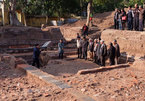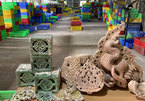 |
| A large number of ancient Chinese porcelain that date back to Tang, Song, Yuan, Ming and Qing dynasties have been discovered at the relic of the Imperial Citadel of Thang Long. — Photo nhandan.com.vn |
The announcement was made by Associate Professor, Dr. Bui Minh Tri, head of Centre for Thang Long Royal Citadel Research at a seminar on Tuesday.
The seminar, entitled Chinese Porcelain in the Song Dynasty in the Thăng Long Palace, was held by the Centre for Thang Long Royal Citadel Research under the Vietnam Academy of Social Sciences. It aimed to serve the research and scientific documentation of Vietnamese and Chinese ceramics in the Ly – Tran period, from the beginning of the 11th century to the end of the 14th century.
According to the Tri, the porcelain of the Song Dynasty (960 -1279) unearthed at the relic is extremely rare and unique. Such findings are vivid examples revealing that Chinese porcelain was used in the ancient Thang Long Palace.
“At the same time, it reflects the exchanging relationship between China and the capital city of Thang Long in history,” he added.
The findings also open up direction for research on the relationship between the porcelain discovered at the Imperial Citadel of Thang Long with contemporary Chinese porcelain.
“It is also a meaningful scientific issue in researching and understanding the relationship, economic and cultural exchange between Thang Long (Vietnam) and China in history,” said the associate professor who is also an expert on Vietnamese ancient pottery.
At the relic of the Imperial Citadel of Thang Long, archaeologists also found many Vietnamese ceramics from the Ly dynasty (1009–1225) with a technological level equivalent to those of the Song Dynasty of China and with many indistinguishable similarities.
The seminar provides a scientific basis for clarifying the fundamental value of archaeological discoveries and practically contributes to the preservation and promotion of the value of the heritage site.
Commenting on the similarities and differences between the types of porcelain in the Song and Ly Dynasties, Dr. Nguyen Dinh Chien from Vietnam National Museum of History said the comparison results partly reflected that Vietnamese porcelain had absorbed certain influences in shaping and decorating stages, thereby showcasing the creativity and achievements of the profession in Vietnamese history.
“Ly Dynasty was a very glorious era for Vietnamese ceramic as the period produced various glazed lines like celadon, white glaze, brown glaze and green glaze. From the brown glaze line, the Ly Dynasty developed to brown floral pottery, a brilliant and prideful achievement of the profession during the Ly Dynasty,” he said.
At the seminar, the specialists also discussed and analysed many issues such as the excavation of Song porcelain in the Vuon Hong (Rose Garden) area; characteristic and the scale of Chinese ceramic exported to Africa during the 9th and 10th centuries and its variations. VNS

Thang Long Imperial Citadel - the lost treasure
Since the meaningful historical relics were unveiled, the entire ruins of the Thang Long Imperial Citadel have been well preserved and introduced to the public.

New excavation unearths citadel's secrets
The "secrets" of the Thang Long Imperial Citadel complex, including the ancient citadel itself, are continuing to reveal themselves to archaeologists from the Thang Long - Hanoi Heritage Conservation Centre and the Institute of Archaeology.